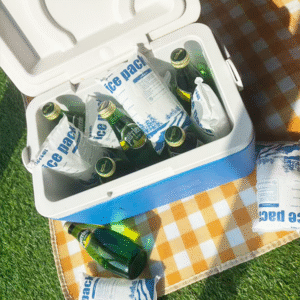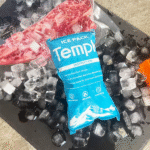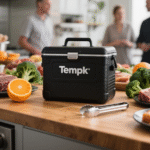Every food business wants meal kits to arrive fresh and safe. Usando un meal prep dry ice pack sheet can keep your prepared foods frozen without the mess of melting water. These flexible sheets encapsulate solid carbon dioxide that sublimates at –78.5 °C (–109.3 °F), allowing shipments to stay at ultra cold temperatures for days. In this guide you’ll learn what a dry ice pack sheet is, how it works, the differences from gel packs, and how to plan your shipments to maintain quality. We’ll also cover the latest 2025 trends and offer actionable advice so you can manage cold chain logistics like a pro.
What is a meal prep dry ice pack sheet and how does it work? – understand the science behind sublimation and why it keeps meals dry.
How do you use dry ice pack sheets for meal prep deliveries? – learn step by step packing instructions and calculate how much dry ice you need.
Why choose dry ice pack sheets over gel packs in 2025? – explore benefits like longer cold life and zero moisture.
Safety and environmental considerations – avoid frostbite, respect regulations, and understand disposal of gel pack innards.
2025 innovations and market trends – discover smart sensors, hybrid refrigeration and how the cold chain refrigerant market is growing.
What Is a Meal Prep Dry Ice Pack Sheet and How Does It Work?
A meal prep dry ice pack sheet is a flexible, vacuum sealed pouch filled with solid CO₂ pellets or blocks that sublimate directly into gas, keeping your products ultra cold without melting. Traditional gel packs freeze around 0 °C and slowly melt; dry ice bypasses the liquid phase entirely. This sublimation at –78.5 °C absorbs large amounts of heat, maintaining temperatures as low as –78.5 °C for 24–72 hours depending on the sheet size and insulation. Because the carbon dioxide escapes as gas, packages stay moisture free and there’s no risk of soggy boxes or damaged labels.
Dry ice pack sheets come in various sizes. Mini sheets are ideal for meal kits requiring –20 °C for 24 horas, while larger disposable sheets can maintain –18 °C to –78.5 °C for up to 72 horas. They are designed to be quick to activate: simply pre freeze or fill them with dry ice pellets, then wrap them around meal prep containers inside an insulated bag. Unlike loose pellets, the sheet format spreads cold evenly and reduces point contact freezing.
How Dry Ice Pack Sheets Differ From Traditional Gel Packs
Dry ice pack sheets and gel packs both fall under cold chain refrigerants, but their properties differ significantly. Dry ice pack sheets use solid CO₂ to maintain sub zero temperatures and produce no liquid residue. paquetes de gel use water based gels that freeze at around 0 °C; they melt gradually and can keep food chilled (no congelado) for 24–48 hours. Gel packs are perfect for products that must stay between 2–8 °C, such as fresh proteins or medicine, but are unsuitable for meals that need to remain frozen. Mientras tanto, dry ice’s extreme cold can damage products sensitive to freezing, so a sealed barrier between the sheet and food is essential.
| Comparación | Hoja de hielo seco | Paquete de gel | Impact on your meal prep |
| Rango de temperatura | –78.5 °C to –18 °C | 0 °C a 8 °C | Choose dry ice pack sheets for frozen meals; gel packs for chilled ingredients |
| Cold duration | 24–72 hours depending on sheet size and insulation | ~24–48 hours | Dry ice sheets offer extended frozen storage for long transit times |
| Humedad | Sin residuos líquidos; se sublima en gas | Produces meltwater that must be contained | Keeps packaging dry and reduces mess |
| Safety considerations | Requires handling with gloves and ventilation | Minimal safety concerns but gel contents may irritate skin if leaked | Dry ice sheets need careful handling; gel packs are user friendly |
| Reutilizabilidad | Some formats are reusable; others are disposable | Mostly reusable | Evaluate life cycle costs based on frequency of use |
Practical Tips and Scenarios
Shipping meal kits: For a 24 hour delivery of 10 lb (4.5 kilos) of frozen meals, plan for roughly 10 libra de hielo seco; this 1:1 ratio maintains frozen temperatures for up to 48 horas. Use high quality insulation to extend performance.
Local meal prep pickup: If customers pick up meals within two hours, los paquetes de gel pueden ser suficientes. They provide chilled temperatures without the hazard of dry ice.
Weekend camping: A hybrid approach (gel packs plus dry ice pack sheets) slows down sublimation and extends cooling beyond 72 horas.
Caso real: A regional meal delivery service switched from gel packs to small dry ice pack sheets for its frozen entrées. By combining mini sheets with a well insulated liner, they maintained –20 °C for 30 hours during summer, reducing spoilage rates and improving customer satisfaction.
How Do You Use Dry Ice Pack Sheets for Meal Prep Deliveries?
Packing meal kits with dry ice pack sheets requires planning to maximize safety and efficiency. Start by choosing a sturdy, insulated container—Styrofoam or vacuum insulated panels work well. Line the container with a layer of polystyrene foam (no hermético) to improve insulation.
Prepare your meals: Seal food in airtight containers or vacuum sealed bags. This prevents moisture ingress and avoids direct contact with dry ice.
Activate the sheet: Remove the dry ice pack sheet from the freezer or fill refillable cells with dry ice pellets. Wear insulated gloves and eye protection when handling dry ice.
Position the sheet: Place the dry ice pack sheet on top of the meals or wrap it around the sides. For shipments under 12 horas, place the sheet on top; Para duraciones más largas, use additional sheets or bottom placement following guidelines (see table below).
Ventilación: Ensure the container or cooler has small holes or venting to allow carbon dioxide gas to escape and prevent pressure build up. Never seal dry ice in plastic bags or airtight boxes.
Label and mark: Label the package with “Dry Ice (Y 1845)” and indicate the net weight of dry ice. FedEx guidelines state that packages must list the proper shipping name, UN number and weight.
Plan for quantity: Para envíos al día siguiente, use half the weight of your payload in dry ice; equal weight covers up to 48 horas, y 1.5 times the weight provides roughly 72 hours of frozen protection.
Deshacerse de manera responsable: Después de la entrega, allow the dry ice to sublimate outdoors and dispose of packaging materials responsibly (more on environmental considerations later).
Dry Ice Quantity Guide
Use the following rule of thumb chart to estimate the amount of dry ice needed based on meal weight and desired transit time.
| Meal weight | < 12 horas | 24–48 horas | 48–72 horas | Consejos |
| 5 lb (2.3 kilos) | 3 lb dry ice top | 5 lb top | 10 lb top | Use single sheet on top for same day delivery |
| 10 lb (4.5 kilos) | 5 lb top | 10 lb top | 15 lb top | For longer trips use two sheets to maintain –20 °C |
| 20 lb (9 kilos) | 10 lb top | 20 lb top | 30 lb top | Consider bottom sheet placement for 72 hr shipping |
| 40 lb (18 kilos) | 15 lb top + 5 lb bottom | 25 lb top + 15 lb bottom | 40 lb top + 20 lb bottom | Heavy shipments require extra insulation |
User Tips
Short deliveries (bajo 12 horas): one sheet on top is usually sufficient.
Two day shipping: match dry ice weight to the product weight and monitor with a data logger.
Three day shipping: plan for 1.5× dry ice weight and use additional insulation.
Estudio de caso: A subscription meal service shipping 20 lb of prepared meals across two states used 20 libra de hielo seco (1:1 ratio) and thermal liners. Real time sensors showed temperatures stayed below –18 °C for 50 horas, reducing returns and boosting customer trust.
Why Choose Dry Ice Pack Sheets Over Gel Packs in 2025?
Dry ice pack sheets have become the refrigerant of choice for frozen meal kits, y 2025 trends are reinforcing their advantages. Extended cold maintenance is the most cited benefit: dry ice stays cold longer than regular ice or gel packs and often lasts 18–24 hours per sheet. By using multiple sheets, you can maintain low temperatures for days.
Another key advantage is sin residuos líquidos. Gel packs eventually thaw and may leak water that damages packaging or contaminates meals. Dry ice sublimates directly into gas, leaving no mess. This moisture free property is invaluable for sensitive foods like pastries or vacuum sealed entrées.
Dry ice pack sheets are also energy efficient; they do not require refrigeration or electricity during transit. This reduces reliance on powered coolers and expands delivery to remote areas where power is unavailable. For international shipments or long distance deliveries, dry ice ensures consistent low temperatures and reduces spoilage.
Finalmente, dry ice sheets are versátil. They can be combined with gel packs to create hybrid cooling systems that extend the life of both refrigerants. Many meal kit companies use this strategy for weekend deliveries, ensuring the product stays frozen until customers arrive home.
How Much Dry Ice Should You Use for Meal Kits?
Estimating the correct amount of dry ice is essential to avoid under or over cooling. Start with the weight based ratio: half the weight of your payload covers overnight shipments, equal weight maintains frozen conditions for 48 horas, and 1.5× weight is recommended for 72 horas.
Alternativamente, you can apply the general guidelines from shipping experts: 5–10 lb (2.3–4.5 kg) of dry ice for a 24 hour shipment and 10–20 lb (4.5–9 kg) for 48 hour or longer deliveries. Sin embargo, external factors like ambient temperature, insulation quality and meal density influence sublimation. Usar un dry ice calculator or consult your carrier for personalized recommendations.
Self Assessment Tool (Interactive Suggestion)
For engaged users, an interactive self assessment tool could help calculate dry ice needs. You could ask readers to input the weight of their meals, desired transit time and insulation quality. The tool would then output recommended dry ice weight and number of pack sheets. Embedding such a calculator on your website encourages user interaction and reduces guesswork, improving user behavior metrics.
Safety Tips and Environmental Considerations
Handling dry ice requires care. Wear protective gloves and eye protection whenever you handle dry ice to prevent frostbite and irritation. Contact with skin can cause severe burns. Always ensure packaging is vented; sealed containers can rupture when the carbon dioxide gas builds up. Never put dry ice in airtight plastic bags or sealed coolers; choose fiberboard, plastic or wooden boxes with vent holes instead.
Keep shipments well labeled. Carriers like FedEx require packages to display the proper shipping name ("Hielo seco" o "dióxido de carbono, Sólido"), Y 1845 number and net weight. Regulations limit dry ice quantities per package—FedEx allows up to 200 kg for general shipments, while postal services often restrict domestic shipments to 5.5 lb (2.5 kilos). Check your carrier’s rules before shipping.
Environmental Footprint
Dry ice pack sheets are often reutilizable and leave no liquid waste. They are typically made using recycled carbon dioxide captured from industrial processes, supporting circular economy initiatives. En contraste, gel pack innards often contain sodium polyacrylate—a super absorbent polymer that can irritate skin and eyes. Although it is considered non toxic, it doesn’t break down quickly, and disposing of it can clog drains and contribute to landfill waste. Gel packs’ exterior film is usually LDPE plastic (#4), which cannot be recycled through curbside programs and requires drop off at specialized facilities.
To minimize environmental impact:
Reuse where possible: encourage customers to reuse ice packs or offer return programs. Reusing the packs for camping, coolers or future meal deliveries extends their life.
Recycle responsibly: check local regulations for recycling LDPE film and avoid pouring gel contents down the drain.
Opt for sustainable materials: choose dry ice sheets manufactured with recyclable or biodegradable materials and ensure the CO₂ is sourced from industrial capture.
2025 Innovations and Market Trends
The cold chain industry is booming. According to recent analyses, the global cold chain packaging refrigerants market—covering gel packs, foam bricks and dry ice products—was valued at Dólar estadounidense 1.57 mil millones en 2024 and is projected to grow to Dólar estadounidense 1.69 mil millones en 2025 before reaching Dólar estadounidense 2.92 mil millones por 2032, a compound annual growth rate (Tocón) de 8.14 %. The dry ice shipping systems market for frozen food, valorado en Dólar estadounidense 1.42 mil millones en 2024, is forecast to expand at a 7.8 % Tocón a través de 2033. The surge is driven by online food delivery, globalization of food supply chains and rising demand for frozen ready to eat meals.
Latest Technological Advancements
Monitoreo de temperatura inteligente: Internet de las cosas (IoT) sensors integrated into dry ice pack sheets send real time alerts when temperatures deviate. Data loggers help verify compliance during transit and improve accountability.
Embalaje sostenible: Manufacturers are developing recyclable thermal shippers that maintain temperature for more than 72 hours and gel packs using biodegradable materials. Dry ice production increasingly uses CO₂ captured from industrial processes, reducing net emissions.
Blockchain transparency: Distributed ledger technology provides traceability of temperature history and authenticity across the supply chain. This helps verify that meal kits remained within safe temperature ranges.
Hybrid refrigeration: Electric and hybrid transport units combine mechanical cooling with dry ice pack sheets, reducing diesel dependence and lowering emissions.
Ready to use kits: Pre assembled thermal kits simplify training and reduce packing errors. They include insulated boxes, dry ice sheets and data loggers, making adoption easier for small businesses.
Market Insights and Consumer Preferences
Consumers increasingly value sustainability and transparency. Businesses are balancing performance with eco friendly materials and exploring carbon neutral strategies. Materiales de cambio de fase (PCM) and vacuum insulated panels provide precise temperature control while reducing dry ice requirements. Meal delivery services often use mini dry ice sheets to keep frozen meals at –20 °C for 24 horas, while pharmaceutical companies rely on them for –78.5 °C conditions for over 48 horas.
Preguntas frecuentes
Q1: How long do meal prep dry ice pack sheets last? Dry ice sheets typically maintain –78.5 °C to –18 °C for 24–48 hours, and larger disposable sheets can extend to 72 hours when used with quality insulation. paquetes de gel, by comparison, offer 24–48 hours of chilled temperatures.
Q2: Can I reuse dry ice pack sheets? Sí. Some dry ice sheets are refillable—simply insert new pellets into the cells. Others are designed for single use. Inspect for damage after each use and follow manufacturer instructions.
Q3: Are dry ice pack sheets safe for home meal deliveries? Dry ice is safe if handled properly. Usar guantes, ensure ventilation and instruct recipients to allow remaining dry ice to sublimate outdoors. Provide clear instructions with the package.
Q4: What’s the difference between dry ice foam sheets and foam bricks? Foam bricks are reusable refrigerant blocks that freeze around –20 °C; they are suitable for chilled goods but not as cold as dry ice foam, which reaches –78.5 °C. Foam bricks are heavier but safer for home use.
Q5: How can I reduce the environmental impact of using dry ice pack sheets? Use only the amount of dry ice needed, choose products made from recycled CO₂ and biodegradable materials, and reuse or recycle packaging. Avoid pouring gel pack innards down the drain and follow local recycling guidelines for LDPE film.
Summary and Suggestion
Meal prep dry ice pack sheets provide unmatched cooling performance for frozen meal kits. They maintain –78.5 °C to –18 °C for 24–72 hours with no liquid residue. By following weight based guidelines—half the payload weight for overnight, equal weight for two day, and 1.5× weight for three day shipments—you can plan shipments with confidence. Always use insulated containers, label packages clearly and ensure ventilation. Dry ice sheets are superior to gel packs for frozen foods, though gel packs still have a role for chilled products.
To optimize your cold chain, assess your meal weight and transit duration, choose the right dry ice sheet size and invest in high quality insulation. Consider using a calculator to estimate dry ice quantity and adopt IoT temperature monitoring for transparency and compliance. Finalmente, stay informed about 2025 trends—sustainable materials, smart sensors and hybrid refrigeration—to maintain a competitive edge.
Acerca de Templ
En Templ we specialize in high performance temperature control solutions. Nuestro Hojas de paquete de hielo seco and foam products provide ultra cold temperatures without moisture, ensuring that your meal kits, pharmaceuticals and biologics arrive safely. We design reusable and disposable sheets, insulated boxes and IoT monitoring tools to fit your specific needs. Our commitment to innovation and sustainability means we source CO₂ from industrial capture and explore biodegradable materials. Whether you need help selecting a meal prep dry ice pack sheet or want to build a resilient cold chain, our team is ready to provide customized solutions.
Siguientes pasos: Contact our experts to discuss your cold chain requirements or request a sample pack. Use our self assessment tool to calculate your dry ice needs and explore our knowledge base for more guides.
























